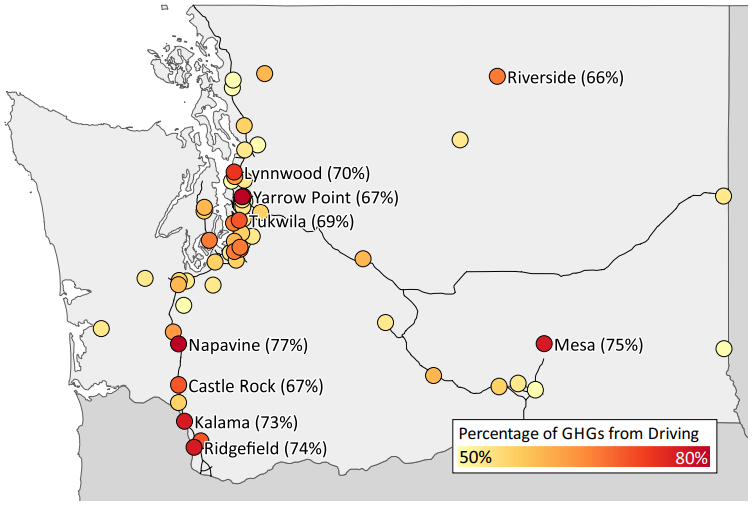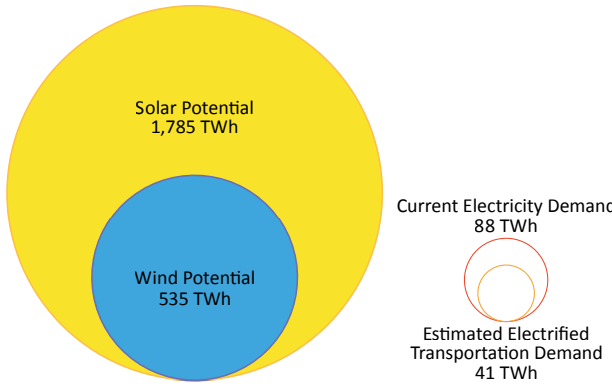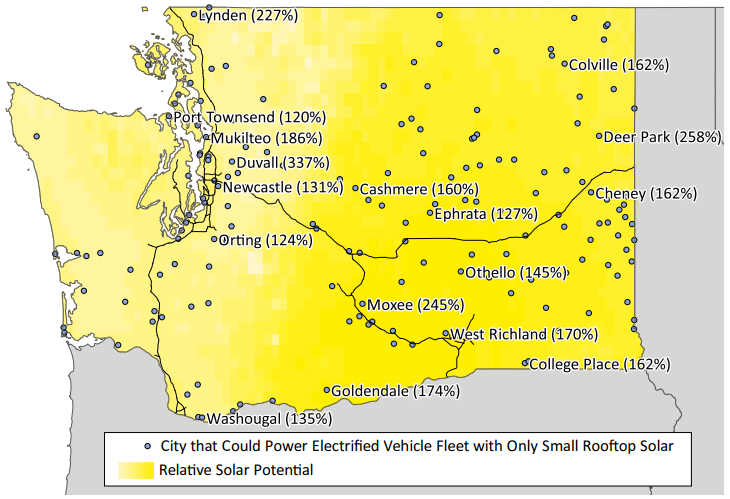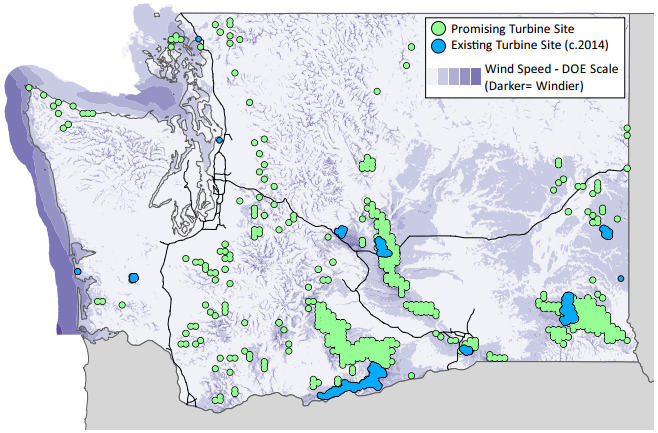Road to a Fossil Free Washington
How Electric Vehicles and Renewable Energy Can Repower Washington State
This report finds that Washington has the wind and solar resources to meet all of our energy needs, while also powering an electrified, emission-free transportation system in which our existing vehicle fleet is fully replaced with electric cars, trucks and buses. The time has come for Washington to aggressively expand the use of electric vehicles … and to ensure that they are fueled by energy from the sun and wind by setting strong goals for production of renewable energy.
Downloads
Executive Summary
Washington’s transportation system is powered almost entirely by fossil fuels. Our dependence on oil for transportation pollutes our air and water, contributes to global warming, and results in people from Seattle to Spokane sending billions of dollars a year out of the state and out of the country to purchase fossil fuels.
There is a better way. By switching to electric vehicles (EVs) that can run on renewable energy, Washington can clean our environment, meet our climate goals, and build a vibrant clean energy economy that uses energy produced here at home. At the same time, widespread adoption of electric vehicles can help Washington bring more renewable energy online – further reducing our dependence on fossil fuels to heat and power our homes and businesses.
Washington has the wind and solar resources to meet all of our energy needs, while also powering an electrified, emission-free transportation system in which our existing vehicle fleet is fully replaced with electric cars, trucks and buses. The time has come for Washington to aggressively expand the use of electric vehicles … and to ensure that they are fueled by energy from the sun and wind by setting strong goals for production of renewable energy.
Powering transportation with clean energy can help Washington meet our biggest environmental challenges.
• Air pollution – Vehicle exhaust is a leading source of the air pollution that contributes to smog and can worsen asthma. More than one third of Washington residents are in an age group or have a medical condition that puts them at greater risk from air pollution.
• Water pollution – By reducing or eliminating the need for the petroleum supply chain, EVs can reduce risks to water posed by spills during the extraction, transportation, and refining of oil. EVs generally do not require motor oil, and reduce the use of other oil-based lubricants, which are major components of runoff pollution. A 2010 study found that at least 21 million pounds of oil, grease, and petroleum runoff pollution enter the Puget Sound each year.
• Global warming – Transportation is by far the largest source of global warming pollution in Washington state, with double the emissions of any other sector of the economy. Driving accounts for more than half of global warming emissions in 55 of Washington’s 281 cities and towns. A 2016 report commissioned by the state of Washington concluded that, to achieve an 80 percent reduction in emissions by 2050, passenger transportation “must shift from internal combustion engine (gasoline) vehicles to a fleet almost entirely composed of electric vehicles.”
Figure ES-1. Washington Cities and Towns Where Driving Accounts for Majority of Global Warming Emissions

Electric vehicles are ready to move Washington.
• Hundreds of thousands of battery electric vehicles are already on the road across the country – including 25,000 in Washington, the third most of any state in the country. The number of EVs on Washington’s roads has doubled since the end of 2014. There are at least 15 models of all-electric vehicles on the market, capable of meeting a variety of travel needs.
• There are nearly 700 public EV charging stations across Washington, in cities and along major highways throughout Washington.
• EVs can be integrated quickly into new transportation services like carsharing and ridehailing networks that reduce the burden of car ownership and make our cities better places to live. Cities including Indianapolis and Los Angeles have begun experimenting with EV carsharing, and Seattle carsharing company ReachNow has between 80 and 90 EVs in its vehicle fleet.
• Electric, battery-powered buses and freight trucks are starting to come to market. In 2016, King County Metro put its first electric bus on the road, and in 2017 the agency ordered up to 73 more electric buses, potentially the largest electric bus order in North America. Although electric freight is in its infancy, Tesla, Cummins (a leading company for diesel and natural gas freight engines) and Nikola Motor have all announced electric semi-trucks.
Washington has the clean energy resources to power our transportation system.
• If Washington were to power all of our cars and trucks with electricity, electricity consumption in the state would increase by about 46 percent, assuming no other changes in electricity demand or travel.
• Any increase in electricity generation needed to meet the energy demand for an electrified transportation system could be met using clean, renewable energy. In fact, Washington’s solar potential is equivalent to 20 times the state’s current electricity demand, and its wind potential is equivalent to six times the state’s current demand. Just 5.5 percent of Washington’s wind and solar energy potential could power all current state electricity demand, plus the estimated demand from a fully electrified vehicle fleet.
• Many cities and towns in Washington have the renewable energy potential to meet the needs of an electric transportation system. Of Washington’s 281 cities and towns, 167 could produce more electricity from small rooftop solar installations than would be needed to power all electrified vehicle transportation within municipal limits (assuming that all of that power is dedicated to transportation). Solar energy generated on medium and large buildings, along with solar and wind energy generated outside urban areas, can meet additional electricity demand.
Figure ES-2. Just 5.5 Percent of Washington’s Wind and Solar Potential Could Power Current Electricity Demand Plus Estimated Demand from a Fully Electrified Vehicle Fleet

Figure ES-3. Map of 167 Washington Cities and Towns that Could Power Electrified Vehicle Fleet with Only Small Rooftop Solar
Map shading represents relative solar potential.

Electric vehicles can expand Washington’s ability to eliminate fossil fuels from our power supply and our buildings.
• Electric vehicles can help accommodate the daily variations in the availability of energy sources such as solar and wind power, potentially speeding Washington’s ability to transition to clean energy.
• By managing charging to absorb excess solar and wind power from the grid, EVs can limit the amount of renewable energy that goes wasted and improve the economics of renewable energy development. Smart charging will also allow EVs to briefly reduce or halt charging in order to avoid overtaxing the grid.
• When not in use, EVs can also feed energy back into the grid, either to help meet energy demand, or to provide “ancillary grid services” to aid grid reliability and stability. These functions can reduce the need for certain grid investments. Compensating vehicle owners for this service could also speed EV adoption, as could allowing EV owners to sell used EV batteries for use as grid energy storage.
A transition to EVs and clean energy would benefit Washingtonians across the state.
• Washington spends nearly $10 billion annually on gasoline and diesel made from oil products that are extracted and imported from out of the state or out of the country. In a transportation system powered by clean energy, much of that money would stay in Washington.
• Already, the nearly 9,000 wind and solar jobs in Washington exceed the number of people employed in the oil and gas industries. Solar energy in Washington has already led to $375 million in investments, and Washington is home to 157 solar companies.
• Eastern Washington in particular would benefit from investment in wind and solar farms, since it is home to the bulk of the state’s renewable energy potential. To date, wind farms have primarily been built in southern and southeastern Washington, and the wind industry has been responsible for $6 billion in investment, 3,000 jobs, and 10 manufacturing facilities in the state.
Figure ES-4. Many of Washington’s Promising Wind Turbine Sites Are in Southern and Eastern Washington

Washington has the potential to replace its current reliance on fossil fuels with clean, renewable energy, including for repowering transportation. Doing so will bring enormous benefits to the state – including making Washington a leader in the fight to prevent the worst impacts of global warming.
To accelerate the change to renewable energy and electric vehicles, state policymakers should take steps including:
• Setting ambitious and enforceable renewable energy goals.
• Removing barriers to renewable energy, including by increasing the amount of net metering that utilities must offer their customers
• Adopting the zero-emission vehicle program, currently in place in 10 states, which requires automakers to sell an increasing number of zero-emission vehicles, including EVs.
• Creating and expanding incentives to promote consumer and commercial adoption of EVs and EV charging infrastructure.
• Supporting community adoption of electric mass transit vehicles, for example by providing technical assistance or helping communities secure grants.
• Expanding EV charging infrastructure across the state.
• Removing any barriers to EV ownership, including Washington’s $100 annual electric vehicle registration fee.
• Working to create a smarter, more modern electric grid capable of integrating large amounts of renewable energy, and that can support charging an electrified transportation fleet.
• Creating pilot programs to integrate EVs and renewable energy, including the creation of vehicle-to-grid charging networks.
• Compensating owners of EVs and charging networks for services provided to the grid, and encouraging the development of a secondary market for used vehicle batteries as a grid energy storage.
Local policymakers also have a variety of tools at their disposal to drive adoption of clean energy, including:
• Cutting red tape, including by making building codes more friendly to solar energy installations.
• Installing charging infrastructure.
• Creating clean energy building codes that require or encourage clean energy installations or charging infrastructure.
• Using clean energy for public buildings and fleets.
• Incentivizing clean energy and EVs.
• Setting community clean energy goals.
